Physical Address
304 North Cardinal St.
Dorchester Center, MA 02124
The small intestine represents 75% of the length and 90% of the surface area of the gastrointestinal (GI) tract, yet neoplasms of the small intestine are rare, accounting for only 1% to 2% of all GI neoplasms and fewer than 1% of all cancers in the United States. Four major types of primary neoplasms arise in the small intestine. They are, in order of descending frequency, adenocarcinomas, neuroendocrine tumors (NETs; “carcinoid tumors”), lymphomas, and sarcomas. The small intestine is also the most common site in the GI tract for involvement by secondary tumors, which are more than twice as common as primary small intestinal tumors. This chapter discusses hyperplasias and heterotopias of the small intestine, polyps, primary adenocarcinomas, NETs, and common secondary tumors of the small intestine. Mesenchymal tumors and lymphomas and are discussed separately in Chapters 17 and 19 , respectively.
Brunner’s glands can proliferate to create small polypoid excrescences, or the gland ducts can be blocked and present as small cystic nodules. These Brunner’s gland lesions are commonly encountered in the duodenal bulb usually as an incidental finding at endoscopy. However, they may also be seen as one of a constellation of findings indicative of peptic duodenitis, including villous shortening and gastric foveolar mucous cell metaplasia of the villous epithelium. The nomenclature of Brunner’s gland lesions is not well established, and a number of diagnostic terms, including Brunner’s gland hyperplasia, Brunner’s gland adenoma , and Brunner’s gland hamartoma , have been used. The distinction between these diagnoses is arbitrary; however, the term Brunner’s gland adenoma is potentially misleading because these lesions do not display epithelial dysplasia. The term Brunner’s gland hyperplasia is preferred to highlight the non-neoplastic nature of the entity. The distinction between Brunner’s gland hyperplasia and Brunner’s gland hamartoma is of no clinical significance, and a diagnosis of Brunner’s gland hyperplasia and hamartoma is usually sufficient in large polypoid lesions. Brunner’s gland cyst may be used for the rare incidental cystic lesion that shows an ectatic Brunner’s gland duct lined by a benign epithelium. Rare adenocarcinomas of the small intestine may show a gastric pyloric gland–like phenotype with small tubular glands and strong MUC6 positivity, which may be mistaken for Brunner’s glands. However, these patients are symptomatic and typically show large, obstructing mass lesions on endoscopy unlike the incidental small nodules characteristic of Brunner’s gland hyperplasia and hamartoma.
The diagnostic criteria for Brunner’s gland hyperplasia are subjective because Brunner’s glands may be normally seen in the lamina propria of the duodenum, particularly within the duodenal bulb. Brunner’s gland hyperplasia may manifest as solitary or multiple nodules that are typically small (<1 cm) and characterized by lobules of glands that are increased in both size and number ( Fig. 6.1 ). The lobules extend into the mucosa and are separated by delicate fibrous septa. Cystic dilation of Brunner’s gland ducts may occur, and small case series of Brunner’s gland cysts have also been reported. The cells are cytologically bland with abundant neutral mucin and small, basally located nuclei with minimal to absent mitotic activity.
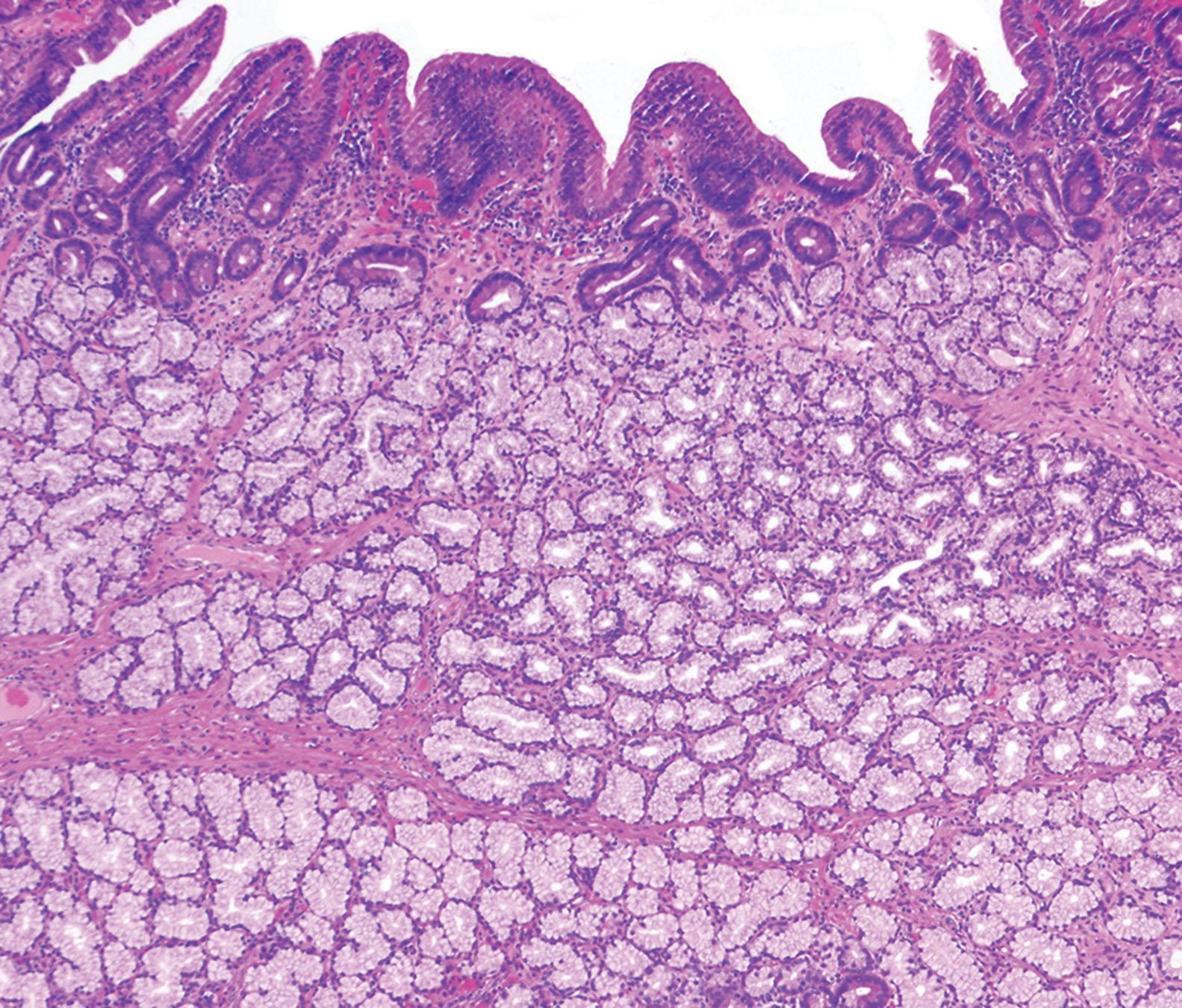
If histologic features indicative of peptic-type duodenal injury are seen, the presence of Brunner’s gland hyperplasia should be attributed to peptic duodenitis. Histologic features of peptic-type duodenal injury include active inflammation within the lamina propria or epithelium, Brunner’s gland hyperplasia, and gastric foveolar metaplasia of the surface epithelium ( Fig. 6.2 ).
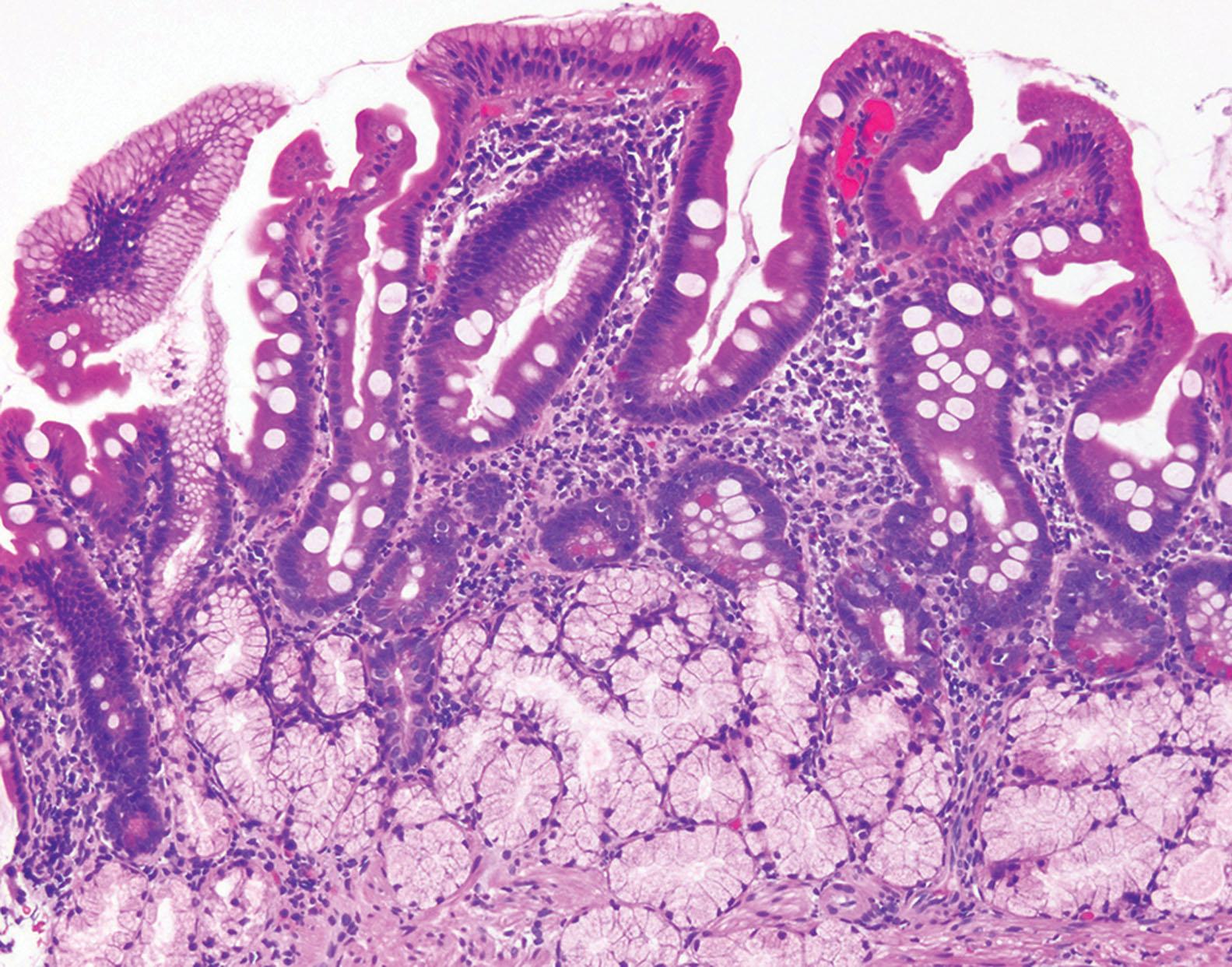
Gastric heterotopias are most commonly identified in the duodenum and are usually incidental small (<1.0 cm) nodules. Gastric heterotopia may be associated with fundic gland polyps of the stomach, suggesting that the increased use of proton pump inhibitors (PPIs) in the general population may enhance its endoscopic detection. The presence of gastric foveolar metaplasia in duodenal biopsies should prompt a careful look for presence of heterotopic oxyntic glands because the increased acid secretion from these glands can also lead to metaplastic change of the surface epithelium.
Biopsies of gastric heterotopias display oxyntic glands composed of chief and parietal cells involving small intestinal mucosa ( Fig. 6.3 ). Gastric foveolar-type mucin is often seen on the surface epithelium adjacent to normal intestinal villi.
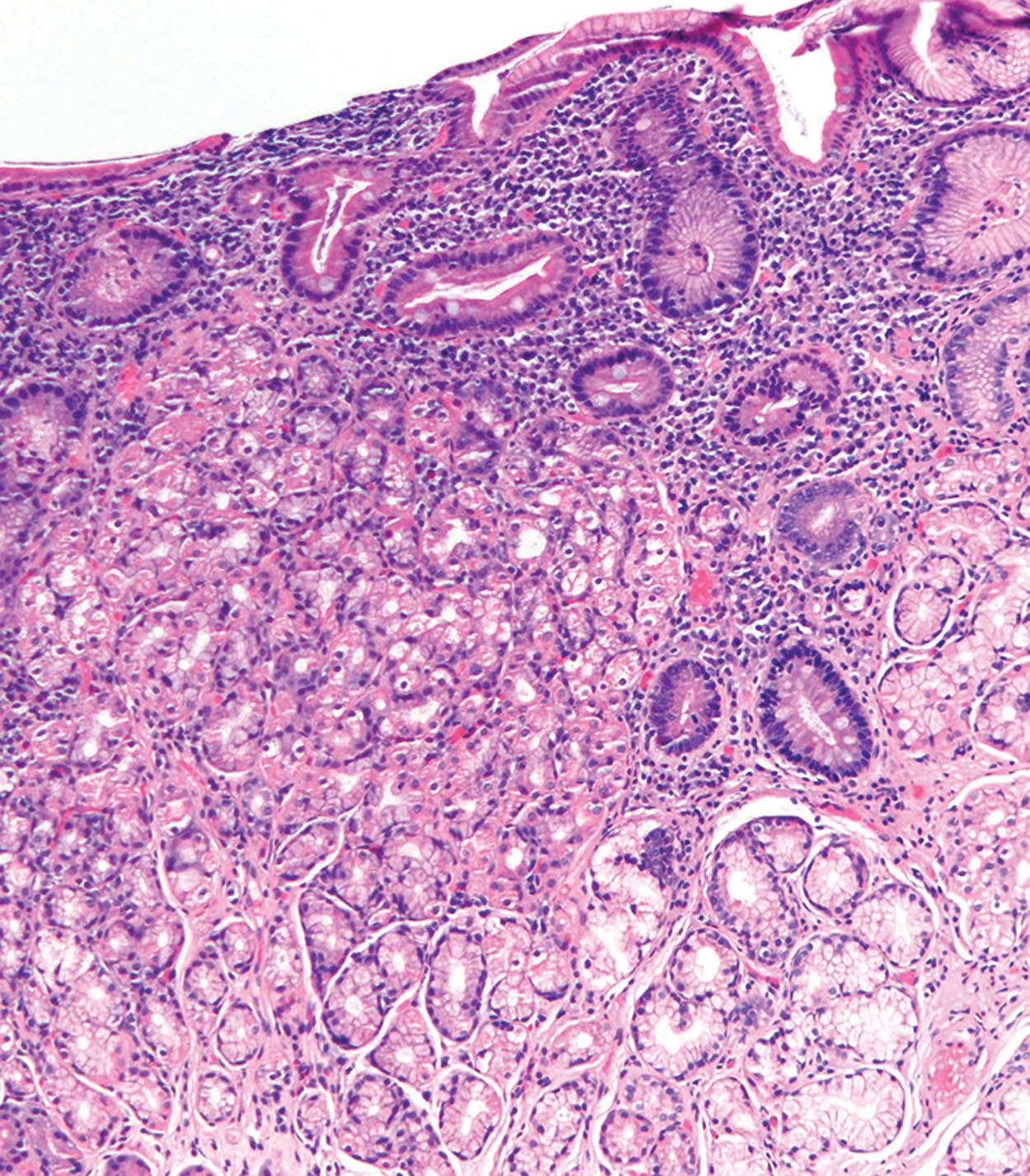
Gastric heterotopia differs from gastric foveolar metaplasia, which is likely a metaplastic response to inflammation caused by peptic injury. Metaplastic gastric foveolar epithelium seen in the setting of peptic injury is not associated with the oxyntic glands characteristic of gastric heterotopia.
Pancreatic heterotopia is synonymous with the terms pancreatic rest and ectopic pancreas . Pancreatic heterotopia of the small intestine is most commonly located in the proximal duodenum and is typically asymptomatic. Mural heterotopias may develop in the periampullary region and may be symptomatic resulting from duodenal obstruction, intussusception, and stricture or stenosis of the ampulla.
Pancreatic heterotopia is composed of pancreatic acini, ducts, or islets either alone or in combination and may be histologically indistinguishable from normal pancreas ( Fig. 6.4 ). Most mucosa-based lesions are not associated with inflammation, and the duodenal mucosa is otherwise normal. Rare cases of ductal adenocarcinoma, mucinous neoplasms, and NETs have been reported to develop in pancreatic heterotopia.
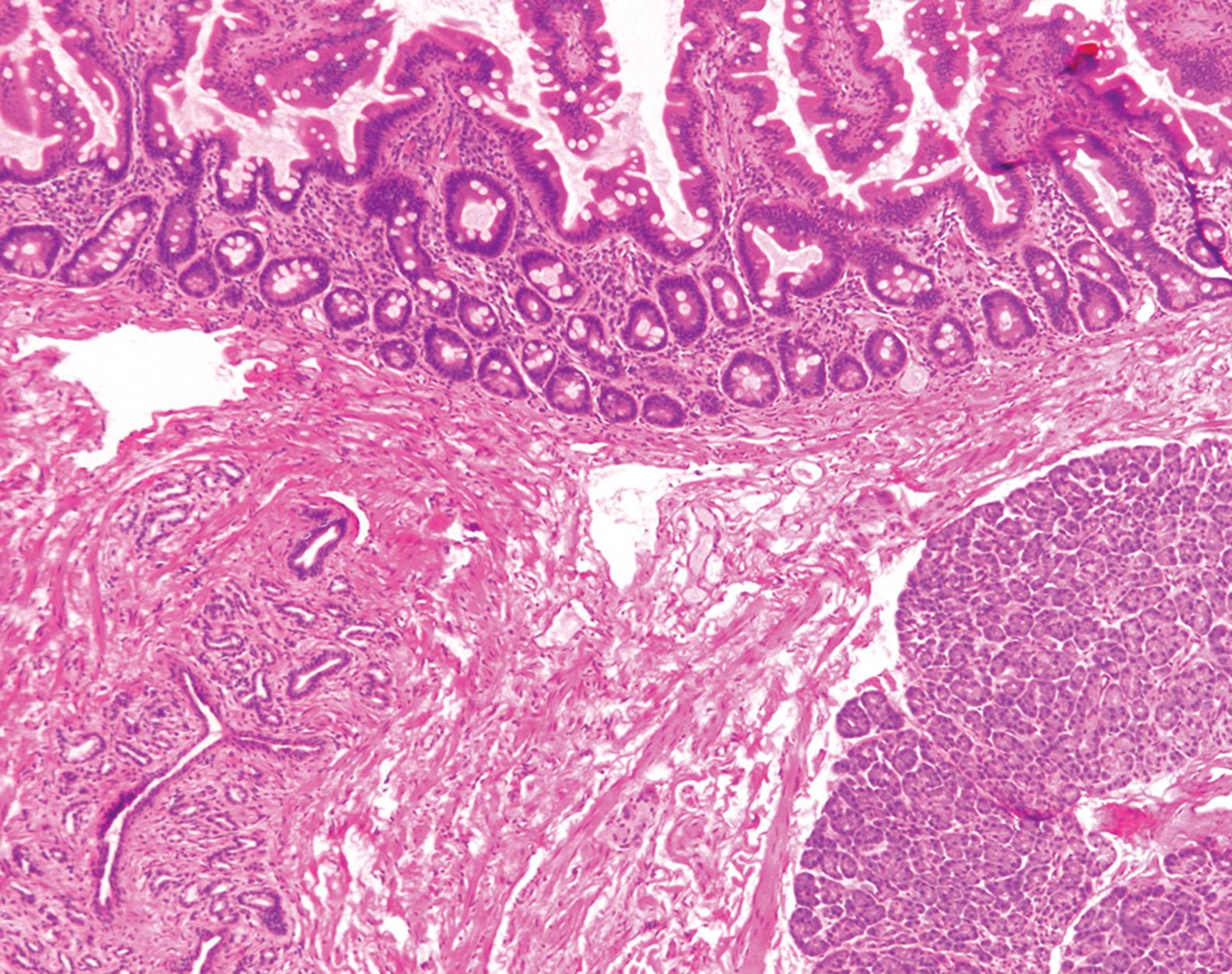
Paraduodenal wall cyst (“groove pancreatitis”) may be confused with mural pancreatic heterotopias because both may contain pancreatic ducts, acini, and islets. Paraduodenal wall cyst typically involves the area of the minor papilla where pancreatic tissue may be normally identified. Unlike pancreatic heterotopia, paraduodenal wall cyst shows significant inflammation and fibrosis and occurs in the so-called “groove” between the superior aspect of the pancreatic head, the common bile duct, and the duodenum. Most cases are characterized by multiple or solitary cysts varying in size from 1 to 10 cm within the duodenal wall and pancreas ( Fig. 6.5 ). Cystically dilated ducts partially lined by ductal epithelium and containing inspissated eosinophilic material are characteristic of this entity. The adjacent stroma often shows pronounced myofibroblastic proliferation, which at times may be mistaken for a mesenchymal tumor.
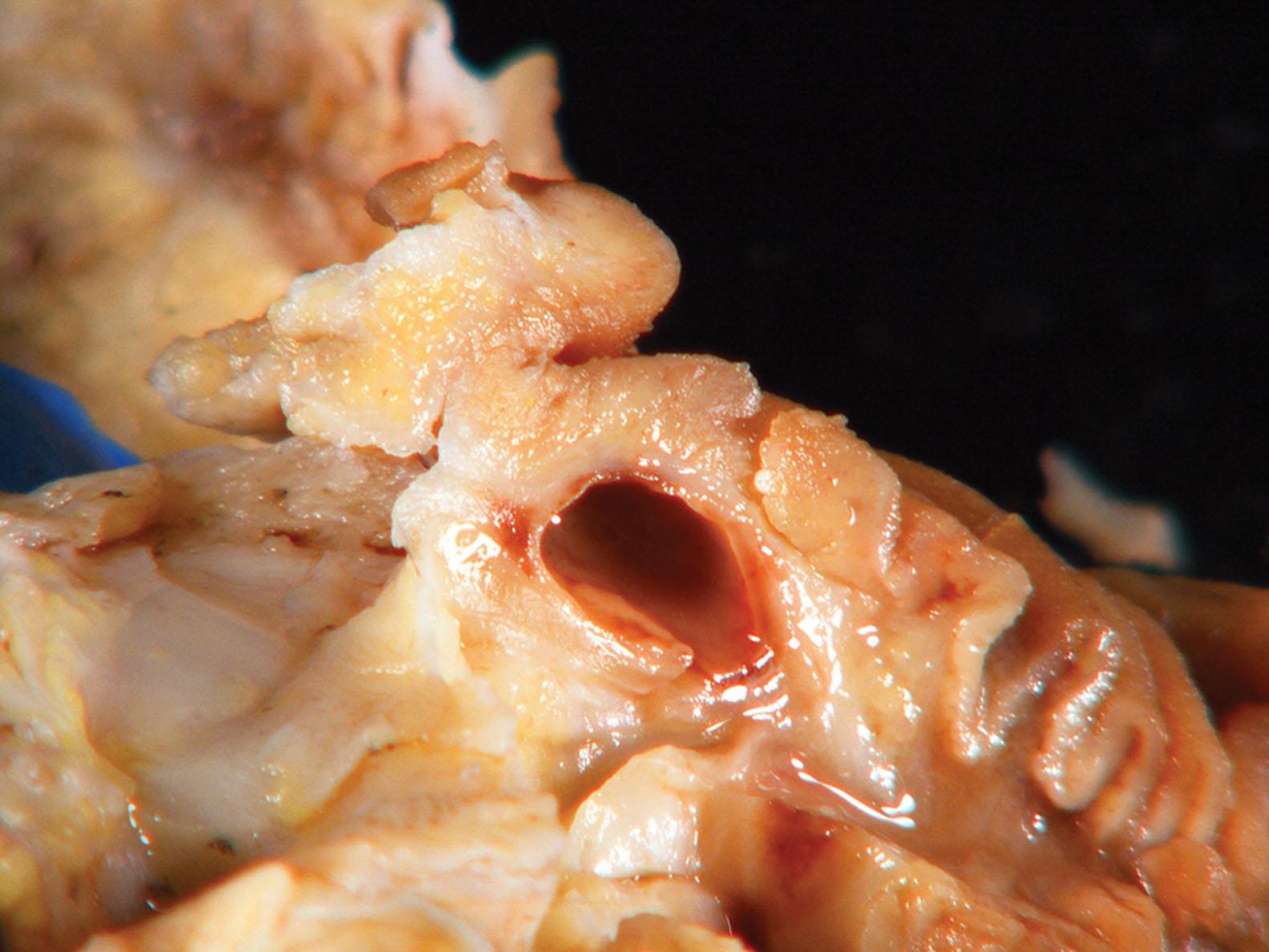
These polyps are more common in the stomach, but pyloric gland adenomas can also occur in the duodenum. They are composed of tightly packed glands lined by cuboidal epithelium with a monomorphic, monolayer of round nuclei located at the base of the glands with abundant eosinophilic to foamy cytoplasm reminiscent of pyloric-type glands ( Fig. 6.6 ). Given their resemblance to Brunner’s glands, the distinction between Brunner’s gland hamartoma and hyperplasia can be difficult. However, pyloric gland adenomas often do not have overlying intestinalized epithelium when they occur in the duodenum. Furthermore, there is no lobular configuration in these lesions in contrast to Brunner’s gland hamartoma and hyperplasia.
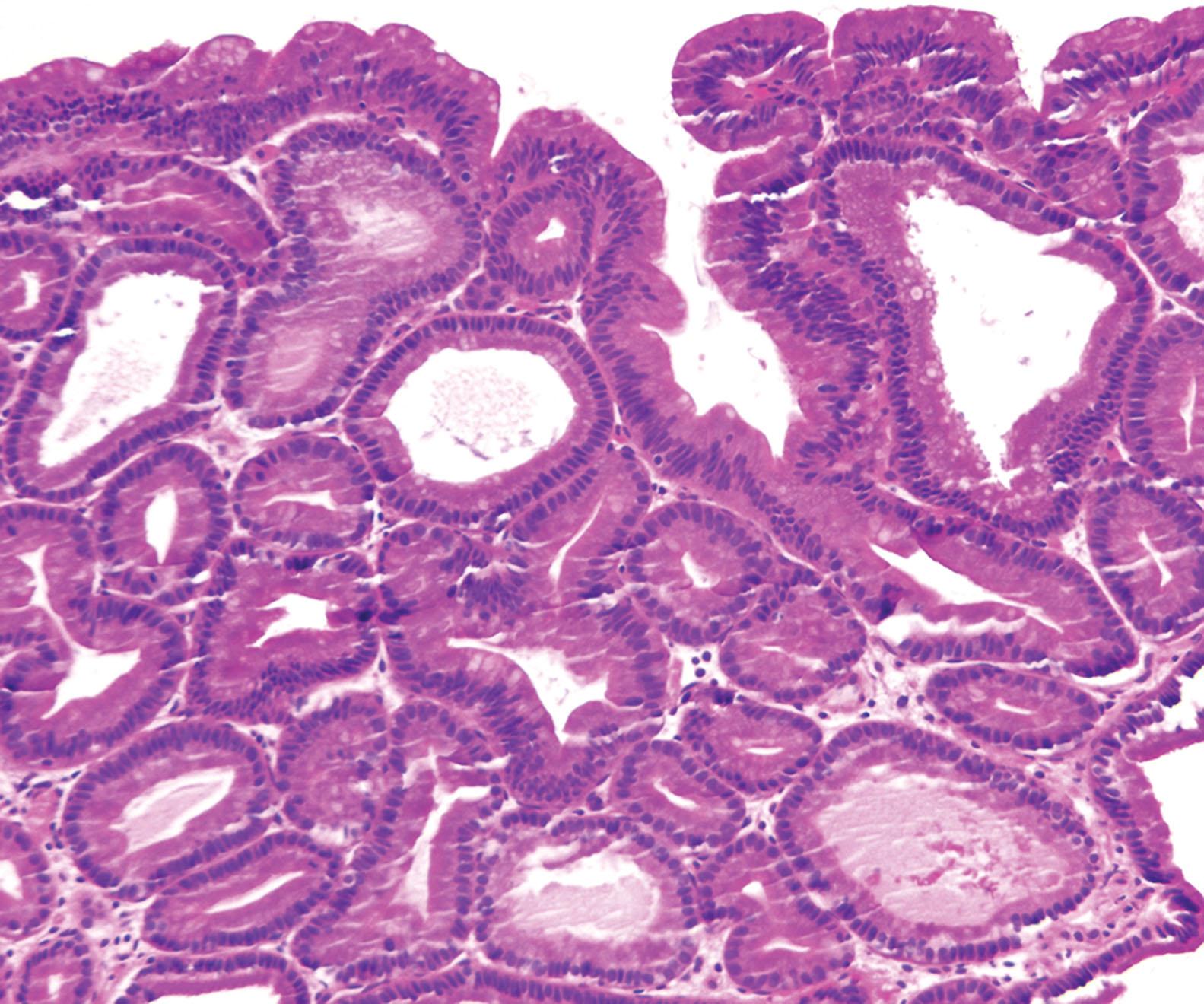
Pyloric gland adenomas exhibit dysplasia, classified as either low or high grade. Between 10% and 30% of pyloric gland adenomas are associated with invasive adenocarcinoma. Given their association with adenocarcinoma, complete endoscopic removal is advised for pyloric gland adenomas. Pyloric gland adenomas can also be seen as an upper GI tract manifestation of familial adenomatous polyposis (FAP), either classic or attenuated, and of Lynch syndrome.
Primary (“nonampullary”) adenocarcinoma of the small intestine is rare, accounting for only 2% of GI tract tumors and 1% of all GI tract cancer deaths. They present in older adults (median age, 72 years) and with a nearly equal gender distribution. Compared with colorectal carcinoma, a higher proportion of small intestinal adenocarcinomas are seen in African Americans than in whites. Like colorectal adenocarcinomas, most small intestinal adenocarcinomas are sporadic and arise from adenomatous polyps. Serrated polyps, both hyperplastic polyps and traditional serrated adenoma-like lesions, may also occur in the duodenum, but are quite rare. Colonic sessile serrated polyp-like lesions have not been described in the duodenum.
Risk factors for sporadic small intestinal adenocarcinoma include smoking and consumption of alcohol, red meat, and fats. Increased body mass index may also be a risk factor. The remaining adenocarcinomas arise in the background of certain predisposing conditions, including polyposis syndromes, Crohn’s disease, Lynch syndrome, gluten-sensitive enteropathy (GSE), and in ileostomies, and ileal conduits. FAP carries the greatest increase in risk for small intestinal adenocarcinoma (100- to 200-fold) followed by Crohn’s disease and GSE, each of which increases the risk 80-fold. Other syndromes with increased risk include Lynch syndrome, Peutz-Jeghers syndrome, and juvenile polyposis syndrome.
The majority of small intestinal adenomas are located in the duodenum, and like their colonic counterparts, exhibit three major histologic types: tubular, tubulovillous, and villous ( Fig. 6.7 ). True traditional serrated adenomas, similar to their colonic counterparts, are incredibly rare ( Fig. 6.8 ). Most adenomas occur singly, and the presence of multiple adenomas in the small intestine is unusual in the absence of FAP, attenuated FAP, or MUTYH -associated polyposis. Because of their potential to undergo malignant transformation, adenomas should be removed completely. Endoscopic polypectomy is appropriate for pedunculated tumors, but large sessile lesions require endoscopic mucosal resection, endoscopic submucosal dissection, or surgical resection. Adenocarcinomas arising sporadically and in the setting of most predisposing conditions also occur most frequently in the duodenum, where 65% are periampullary. The incidence decreases progressively through the rest of the small intestine. Adenocarcinoma arising in Crohn’s disease is a notable exception to this rule. In Crohn’s disease, 70% of adenocarcinomas are found in the ileum, the primary site of the inflammatory process ( Fig. 6.9 ).
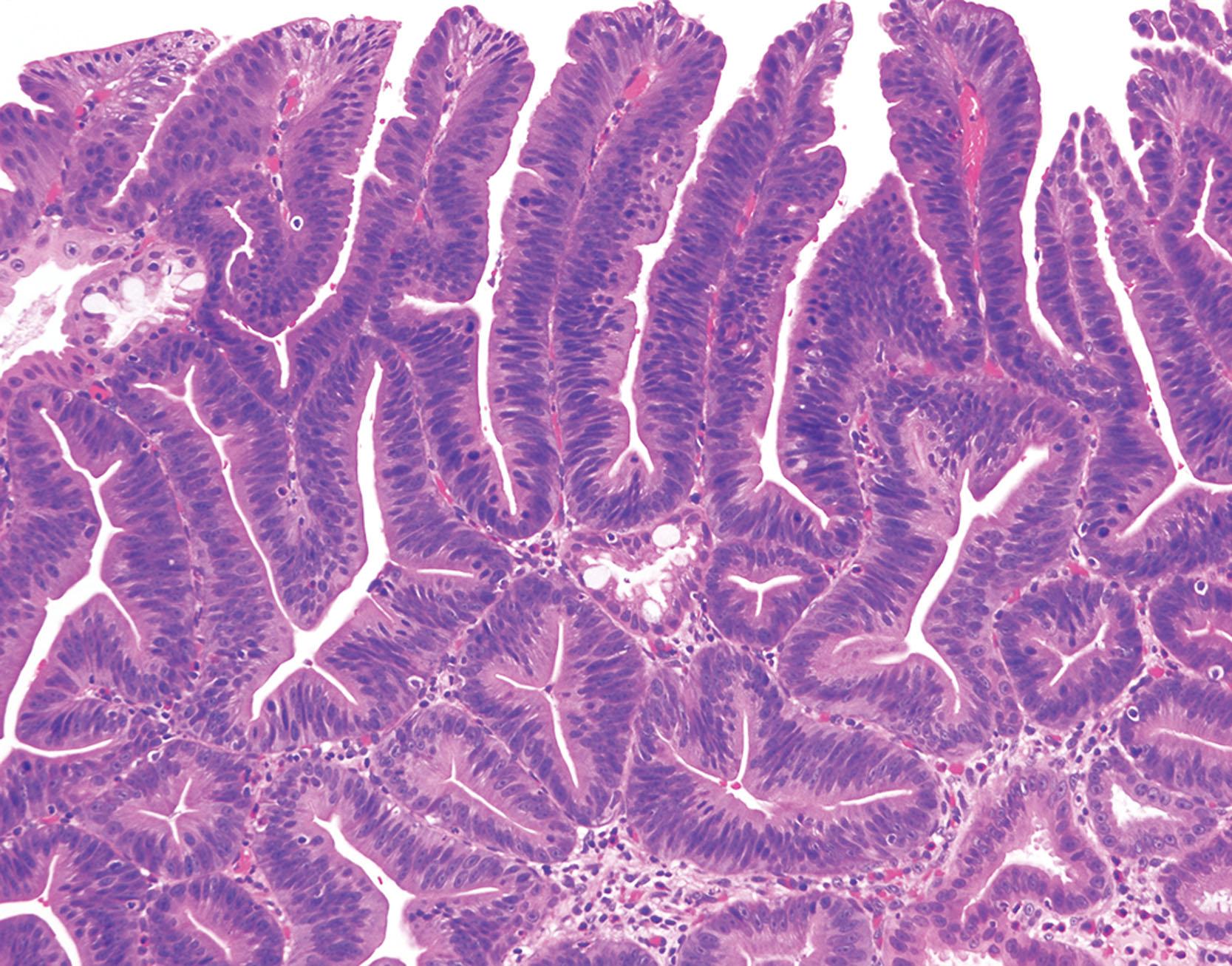
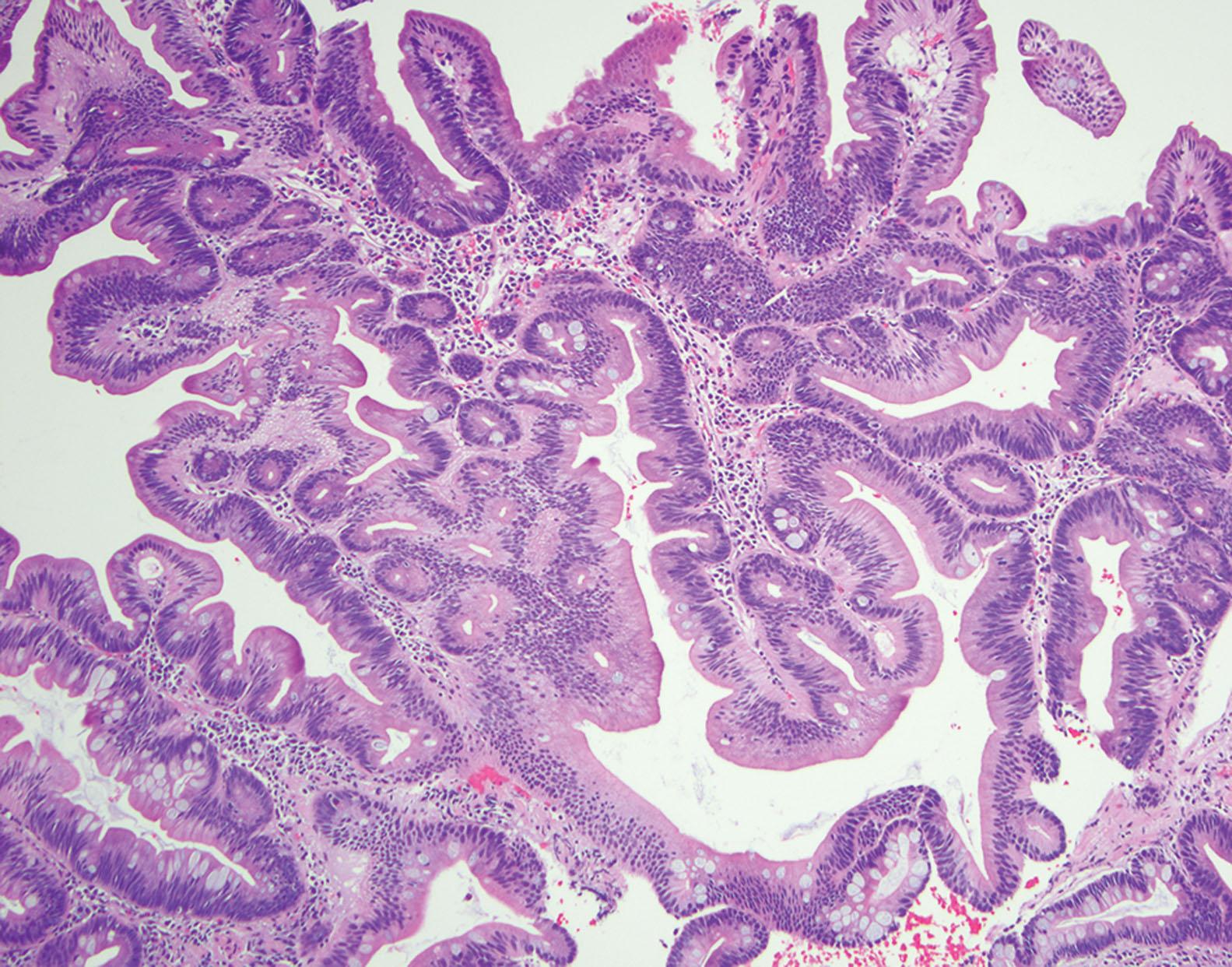
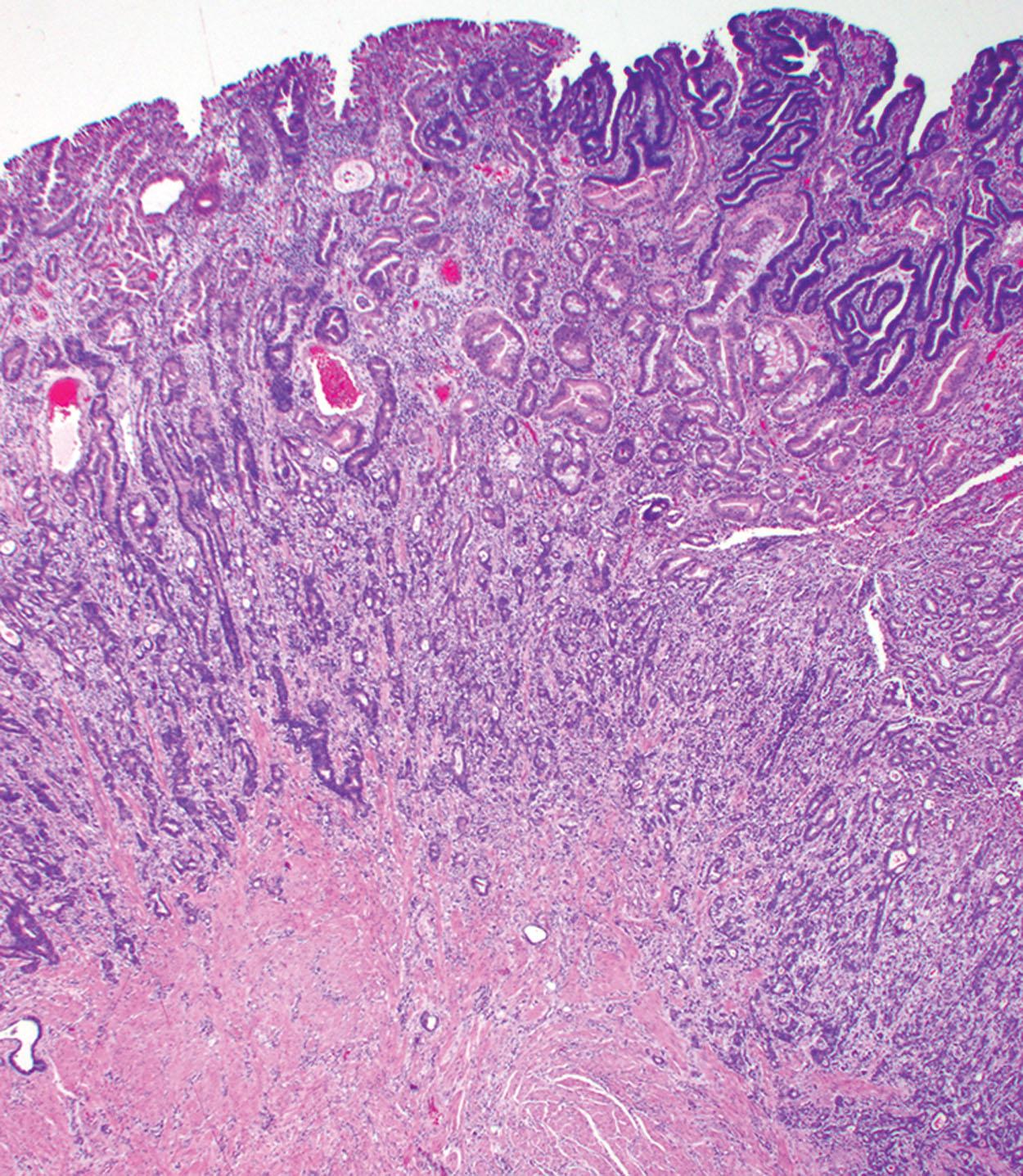
The most common presenting symptoms of small intestinal adenocarcinoma are abdominal pain, obstruction, and occult GI bleeding. Whereas patients with duodenal adenocarcinomas may present with gastric outlet obstruction, the combination of obstructive jaundice with occult GI bleeding is characteristic of ampullary tumors. More distal lesions tend to result in severe, cramping abdominal pain. Intestinal obstruction can be caused by progression of a constricting (“apple core”) lesion or by a large intraluminal polypoid mass. Distal adenocarcinomas tend to present with advanced stage III or IV disease.
Duodenal lesions can typically be detected on routine endoscopy, whereas more distal lesions may require push or capsule enteroscopy, intraoperative endoscopy, or radiographic imaging modalities. Endoscopic ultrasound may be of use to assess depth of invasion and local lymph node metastasis.
The macroscopic appearance depends largely on the site of the adenocarcinoma. The majority of the duodenal and ampullary tumors are small exophytic masses at the time of presentation. Distal tumors tend to be large, annular, constricting (“apple core”) lesions with circumferential involvement of the bowel wall. Rarely, tumors can have a linitis plastica–like appearance. As in the colon, depth of invasion and serosal involvement must be documented.
Duodenal adenocarcinomas require additional sampling to evaluate the depth of retroperitoneal extension and involvement of the pancreas.
Small intestinal adenocarcinomas are histologically similar to colorectal adenocarcinomas ( Fig. 6.10 ). They are characterized by cellular pleomorphism, complex glandular architecture, luminal necrosis (so-called dirty necrosis), and invasion of the lamina propria or muscularis mucosae (intramucosal adenocarcinoma) or deeper into the bowel wall. Most adenocarcinomas are well- to moderately differentiated, and one-third are poorly differentiated. An extremely rare subset of these poorly differentiated tumors may be a manifestation of the recently described SMARCA4 or INI-1 deficient carcinomas, which must be excluded. Histologic grading and classification (e.g., mucinous, adenosquamous) have little bearing on prognosis, which is primarily dependent on anatomic extent, resectability, and lymph node involvement. The majority of small intestinal adenocarcinomas have invaded through the bowel wall at the time of diagnosis. Notably, intramucosal carcinomas of the small bowel are staged as T1a tumors rather than Tis. This is because of the presence of rich mucosal lymphatics that confer metastatic potential to these lesions. Residual adenomatous epithelium from a preexisting adenoma is present in the majority of proximal tumors but often cannot be demonstrated in large, distal small intestinal adenocarcinomas, presumably due to tumor overgrowth. Another subset of cases arise in a background of gastric type dysplasia, presumably likely secondary to peptic duodenitis and gastric heterotopia.
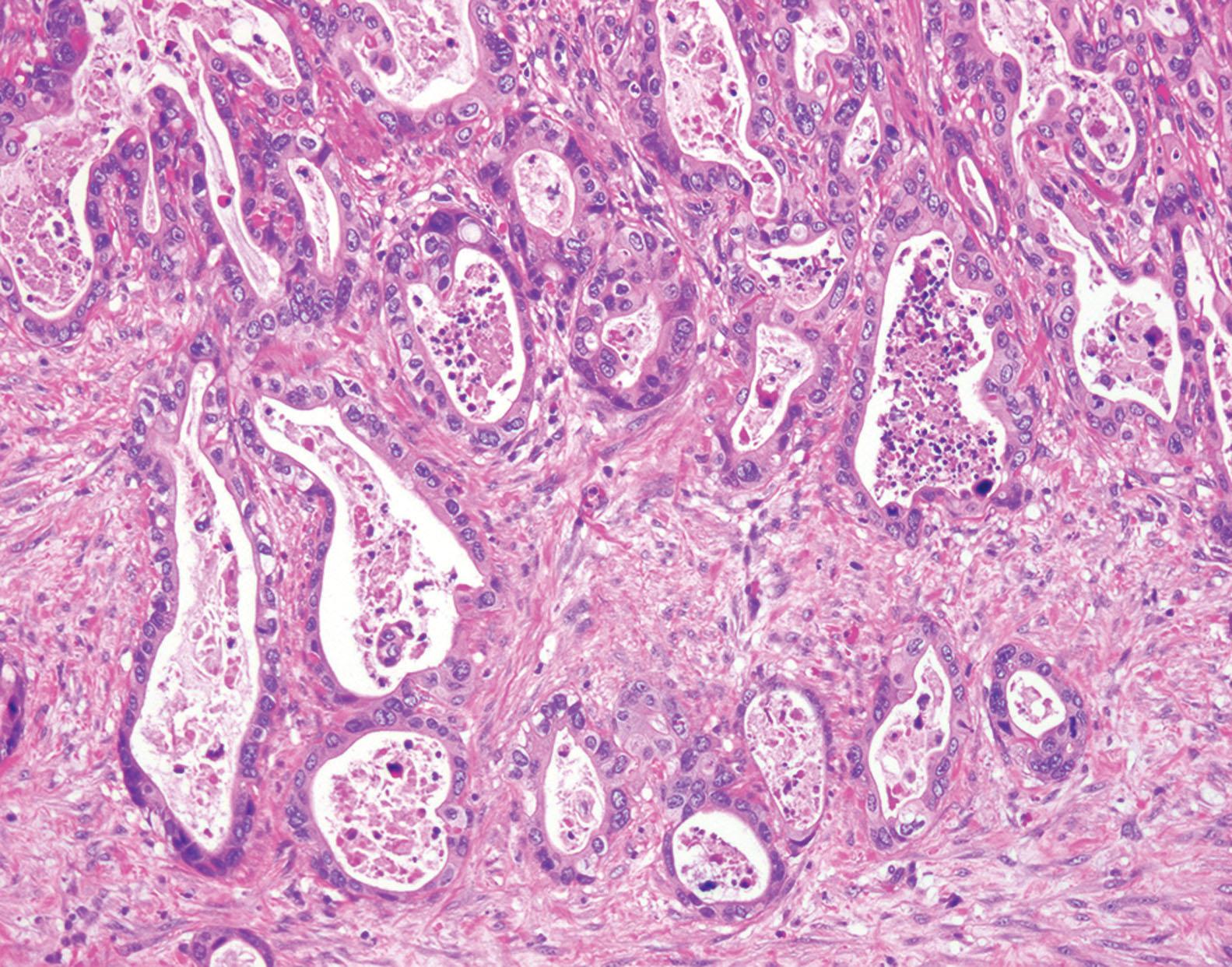
Adenocarcinoma subtypes in the small intestine are similar to those described in the colorectum (see Chapter 12 ) with a few exceptions: pancreatobiliary-type carcinoma and tubular adenocarcinoma have been more commonly recognized in the small intestine whereas serrated adenocarcinoma and micropapillary adenocarcinomas are more prevalent in the colorectum.
The main differential diagnostic consideration is metastatic carcinoma. Immunohistochemistry (IHC) can be helpful in excluding metastatic disease, specifically, metastatic adenocarcinomas (e.g., breast, lung) or other mimickers of poorly differentiated carcinoma (e.g., melanoma, lymphoma). Distinguishing small intestinal adenocarcinoma from metastatic colorectal adenocarcinoma can be challenging. It may be difficult to distinguish adenomatous precursors from colonization of the mucosa by the underlying invasive adenocarcinoma. Adenomatous epithelium can be mimicked by tumors metastatic to the GI mucosa, and a sharp transition from normal to overtly malignant epithelium should raise suspicion for secondary involvement of the mucosa ( Fig. 6.11 ). Knowledge of clinical history in the patient, overall growth pattern (serosal predominant growth), and evidence of disseminated peritoneal disease may be helpful in establishing a diagnosis of metastatic adenocarcinoma to the small intestine. Secondary tumors of the small intestine are discussed in more detail later in this chapter.
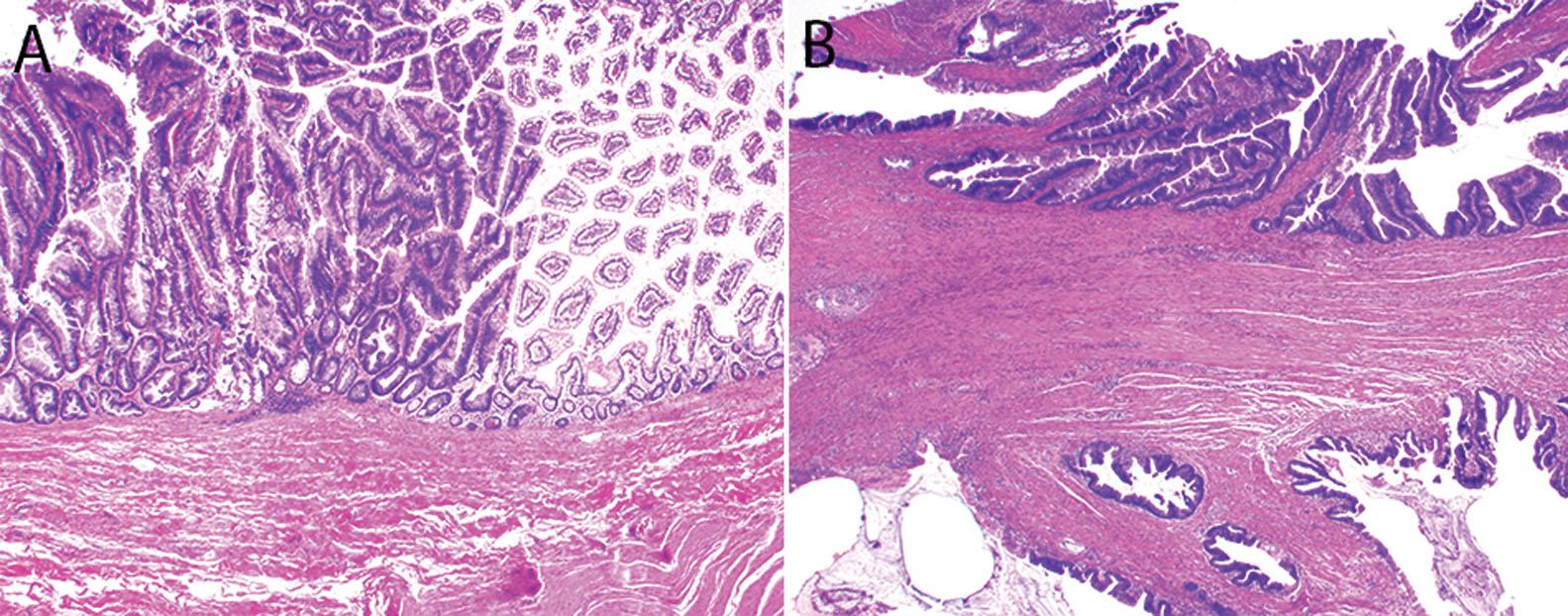
The epithelioid variant of gastrointestinal stromal tumor (GIST) (discussed in Chapter 7 ) may also mimic an adenocarcinoma. In such cases, a more solid growth pattern with lack of gland formation and the relatively bland monotonous appearance of most GISTs, in combination with strong labeling for CD117 and DOG1 by IHC are helpful features. The epithelioid variant of peritoneal malignant mesothelioma may also resemble a primary adenocarcinoma. In contrast to primary small intestinal adenocarcinoma, peritoneal malignant mesothelioma diffusely involves visceral organs, forming either multiple small tumor nodules or completely encasing segments of the intestine. Notably, some epithelioid peritoneal malignant mesotheliomas may demonstrate cytoplasmic vacuolization reminiscent of gland formation and may be associated with extracellular mucoid material mimicking mucin. Most epithelioid malignant mesotheliomas demonstrate strong immunohistochemical labeling for one or more markers of mesothelial differentiation such as calretinin, D2–40, WT1, and cytokeratin 5/6 and do not express the epithelial markers BerEP4 and MOC31.
Endometriosis is a common disease that can involve the GI tract in between approximately 5% and 40% of cases. The small intestine is the second most frequently involved location after the colon. Endometriosis involving the small intestine is typically not a challenging diagnosis and is easy to recognize, given the combination of cellular endometrial stroma and endometrial glands. However, a subset of cases of endometriosis may demonstrate intestinal metaplasia and can mimic invasive adenocarcinoma. Typically, areas of conventional endometriosis will be present, and IHC for markers of endometriosis such as estrogen receptor, progesterone receptor, and CD10 can aid in the diagnosis.
Small intestinal adenomas can be resected endoscopically. Patients with FAP may have innumerable polyps in the duodenum, making endoscopic resection difficult. A scoring scheme has been proposed (modified Spigelman scoring scheme) that takes into account polyp number, polyp size, polyp architecture (tubular, tubulovillous, and villous), and degree of dysplasia (low vs high) in an attempt to risk stratify patients with FAP for the development of invasive adenocarcinoma ( Table 6.1 ). Some patients with modified Spigelman stage IV (e.g., with >20 polyps, polyps >10 mm in size, villous histology, and high-grade dysplasia) are at risk for developing adenocarcinoma and may benefit from pancreaticoduodenectomy.
| Factor | 1 Point | 2 Points | 3 Points |
|---|---|---|---|
| Polyp number | 1–4 | 5–20 | >20 |
| Polyp size in millimeters | 1–4 | 5–10 | >10 |
| Architecture | Tubular | Tubulovillous | Villous |
| Grade of dysplasia | Low grade (mild) | Low grade (moderate) | High grade |
a Stage grouping: stage 0, no polyps; stage I, 1 to 4 points; stage II, 5 to 6 points; stage III, 7 to 8 points; stage IV, 9 to 12 points
Small intestinal adenocarcinomas are aggressive tumors, with a 5-year survival rate of approximately 35%. Survival is diminished in duodenal tumors and in patients older than 75 years of age. Surgery is the treatment of choice and the only modality with curative potential. Small polypoid or superficial tumors may be amenable to endoscopic polypectomy; endoscopic mucosal resection; or in the duodenum, submucosal dissection or a transduodenal resection. Larger proximal lesions may require pancreaticoduodenectomy, and distal tumors require segmental resection with accompanying mesentery. Of note, approximately 8% of small intestinal adenocarcinomas harbor deficient DNA mismatch repair, raising concern of Lynch syndrome. Thus, in the absence of known cancer-predisposing conditions such as Crohn’s disease or FAP, screening of small intestinal adenocarcinomas for mismatch repair protein deficiency can be helpful in identifying patients with possible Lynch syndrome.
The ampulla of Vater is the usual site for convergence of the common bile duct, main pancreatic duct (duct of Wirsung), and duodenum. The ampulla opens through the duodenal papilla and acts as a conduit for bile and pancreatic juices. This unique microenvironment may account for the disproportionate incidence of periampullary adenocarcinomas in the small intestine.
Adenocarcinoma of the ampulla of Vater is associated with adenomas in 80% to 90% of cases. The average age of presentation for ampullary adenomas is the mid-50s, whereas adenocarcinoma typically presents in the mid-60s. Adenocarcinoma is more common in whites than African Americans and more common in men than women. Ampullary adenomas and adenocarcinomas are far more likely to become symptomatic at an earlier stage than neoplasms at other locations in the small intestine. Obstruction of the ampulla frequently produces jaundice and bile duct dilation and occasionally results in pancreatitis, cholelithiasis, or choledocholithiasis. Other findings are nonspecific and include weight loss, abdominal pain, and occult bleeding. Ampullary adenomas and adenocarcinomas are visualized endoscopically or, if large enough, by radiographic imaging.
Sporadic ampullary adenomas ( Fig. 6.12 ) usually present as polypoid masses, between 1 and 3 cm. Adenomas can also be located entirely intra-ampullary, in which case the gross appearance would be of a bulging ampulla rather than an exophytic mass. Adenocarcinomas appear as an infiltrating mass invading nearby structures.
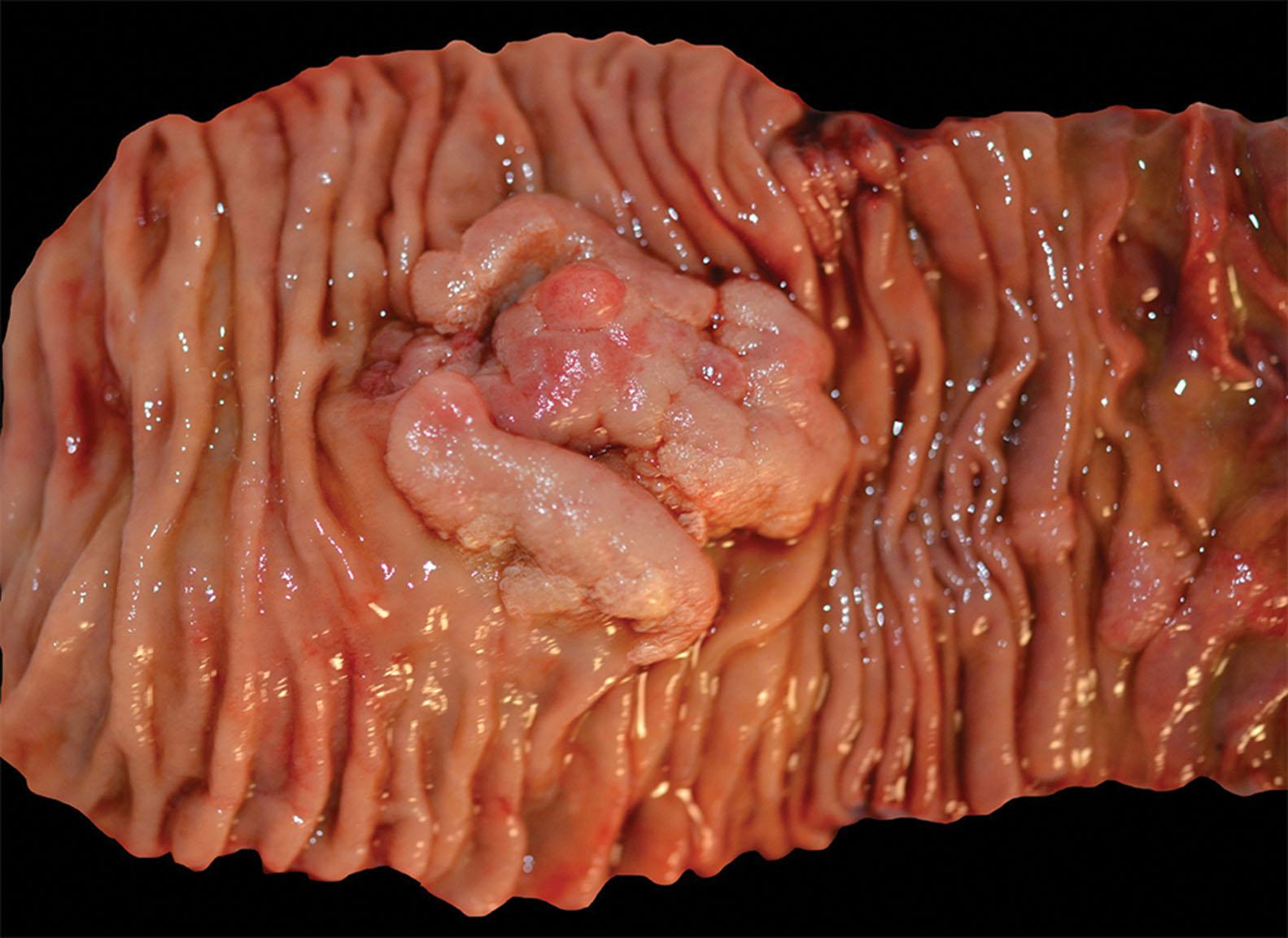
At times, ampullary carcinomas can be difficult to distinguish from duodenal and pancreatic carcinoma. A tumor should be designated as primary to the ampulla in the following scenarios: (1) if the tumor epicenter is located in the lumen or walls of the distal ends (intra-ampullary component) of the bile duct or pancreatic duct or (2) if the epicenter is located at the junction of the duodenal and ampullary mucosa (the “papilla of Vater”) and the ampullary orifice is located clearly within the tumor. Ampullary carcinoma has been further subdivided into four distinctive types primarily based on gross evaluation: (1) intra-ampullary type, defined as prominent intraluminal growth of preinvasive neoplasia in which nodules protrude into the lumen of the ampulla; (2) ampullary-ductal type, defined as infiltrative tumor centered on the walls of the distal ends of the bile duct or pancreatic duct, forming a firm, constrictive lesion; (3) periampullary duodenal type ( Fig. 6.13 ), defined as exophytic growth on the duodenal surface of the ampulla surrounding the ampullary orifice and typically with minimal involvement of the intra-ampullary segment; and (4) ampullary, not otherwise specified ( Fig. 6.14 ), defined as tumors of the papilla of Vater that do not show the characteristics of the other three subtypes.
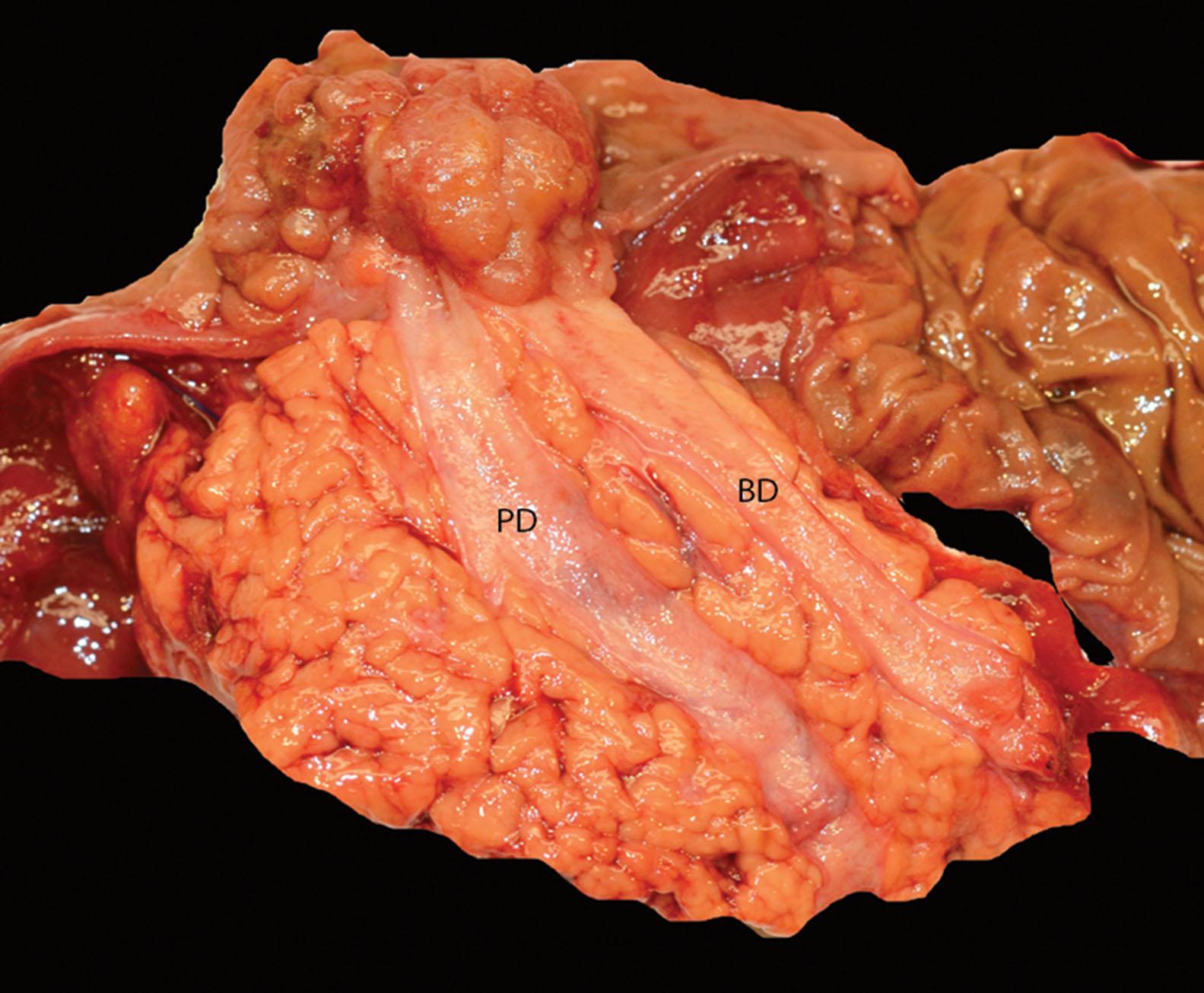
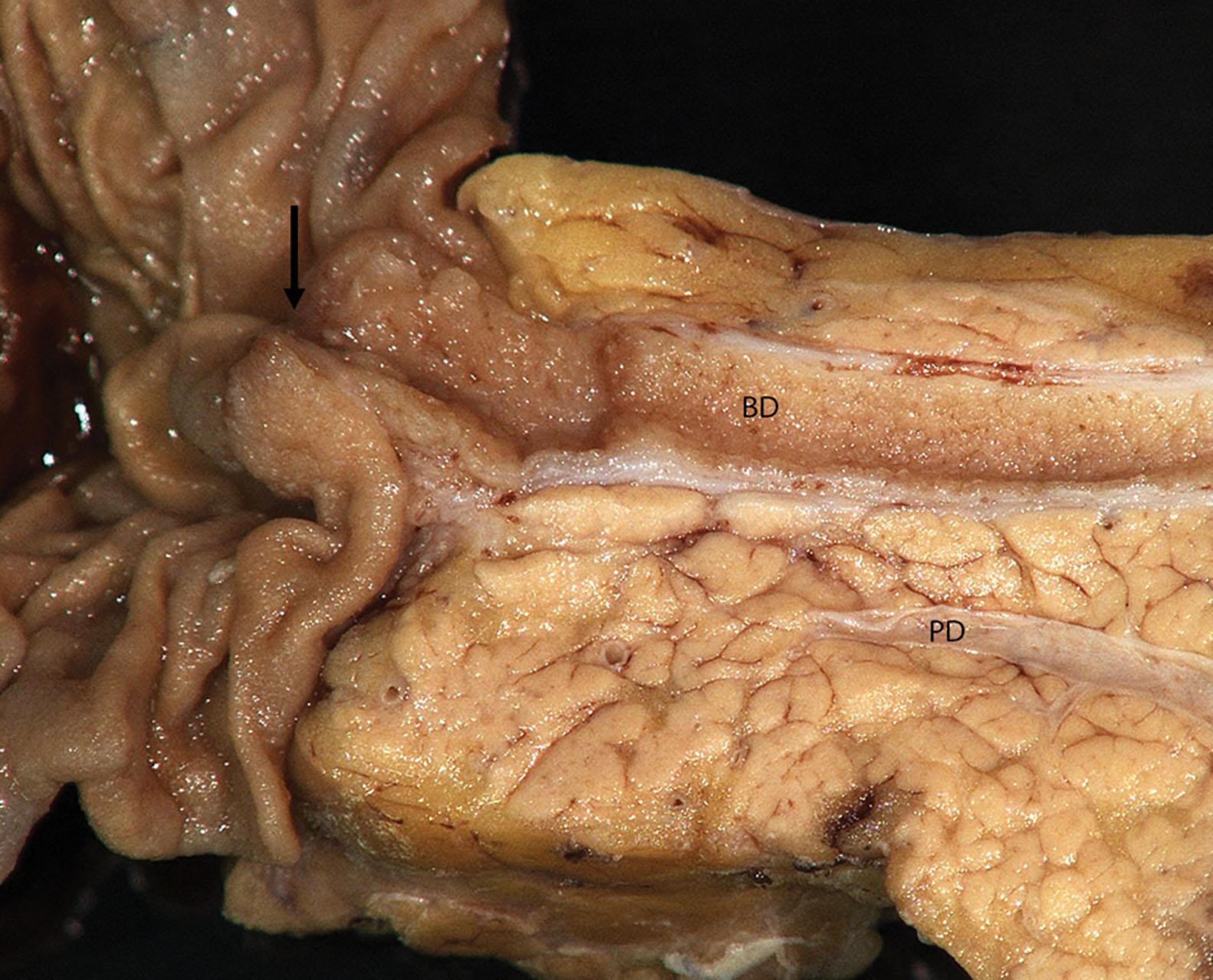
The duodenum-facing surface of the ampulla is lined by intestinal-type epithelium. The mucosa transitions to an admixture of gastric foveolar-type epithelium with intermixed goblet cells and then pancreaticobiliary-type epithelium contiguous with the common bile duct and main pancreatic duct. Most ampullary adenomas demonstrate intestinal-type epithelium similar to other intestinal adenomas. A smaller number of adenomas show a mixture of intestinal-type and pancreaticobiliary-type epithelium. Fewer than 10% of adenomas are composed entirely of pancreaticobiliary-type epithelium. These lesions resemble papillary tumors of the bile ducts and pancreas and have papillary projections with cuboidal epithelium and scant fibrous cores. They lack the abundant Paneth cells and mucin-depleted appearance of polypoid intestinal-type adenomas. The term intra-ampullary papillary-tubular neoplasm has also been proposed in the most recent World Health Organization classification (WHO; 2019) as a synonym for these pancreaticobiliary type ampullary lesions. By definition, the tumor should be confined almost exclusively within the ampulla with minimal extension into the main pancreatic duct, the distal common bile duct, or the duodenal papilla. In addition to typical adenomas, flat adenomas can also be seen in the ampulla.
Adenocarcinomas arising in the ampulla ( Fig. 6.15 ) may be of intestinal type ( Fig. 6.16 ) or pancreaticobiliary type ( Fig. 6.17 ) or display hybrid histologic features. Intestinal-type adenocarcinomas of the ampulla of Vater are identical to those found elsewhere in the small and large intestines and are typically characterized by infiltrating glands lined by columnar cells with elongated, pseudostratified, hyperchromatic nuclei, often with luminal necrosis. The reported proportion of ampullary carcinomas with predominant intestinal-type morphology varies widely in the literature with a range between 30% and 70%. Pancreaticobiliary-type adenocarcinomas are very similar to adenocarcinomas of the pancreas and extrahepatic bile ducts and are composed of small glands lined by low cuboidal eosinophilic epithelium with high nuclear-to-cytoplasmic ratio, pleomorphic nuclei, vesicular chromatin, and irregular nuclear contours. The glands are surrounded by a prominent desmoplastic stroma, and features of intestinal adenocarcinomas, such as pseudostratification and luminal necrosis, are typically lacking. However, distinction between intestinal and pancreaticobiliary-type adenocarcinoma can be challenging with only moderate interobserver agreement noted in most studies. In addition, as many as 40% of ampullary adenocarcinomas can display a hybrid intestinal and pancreaticobiliary morphology.
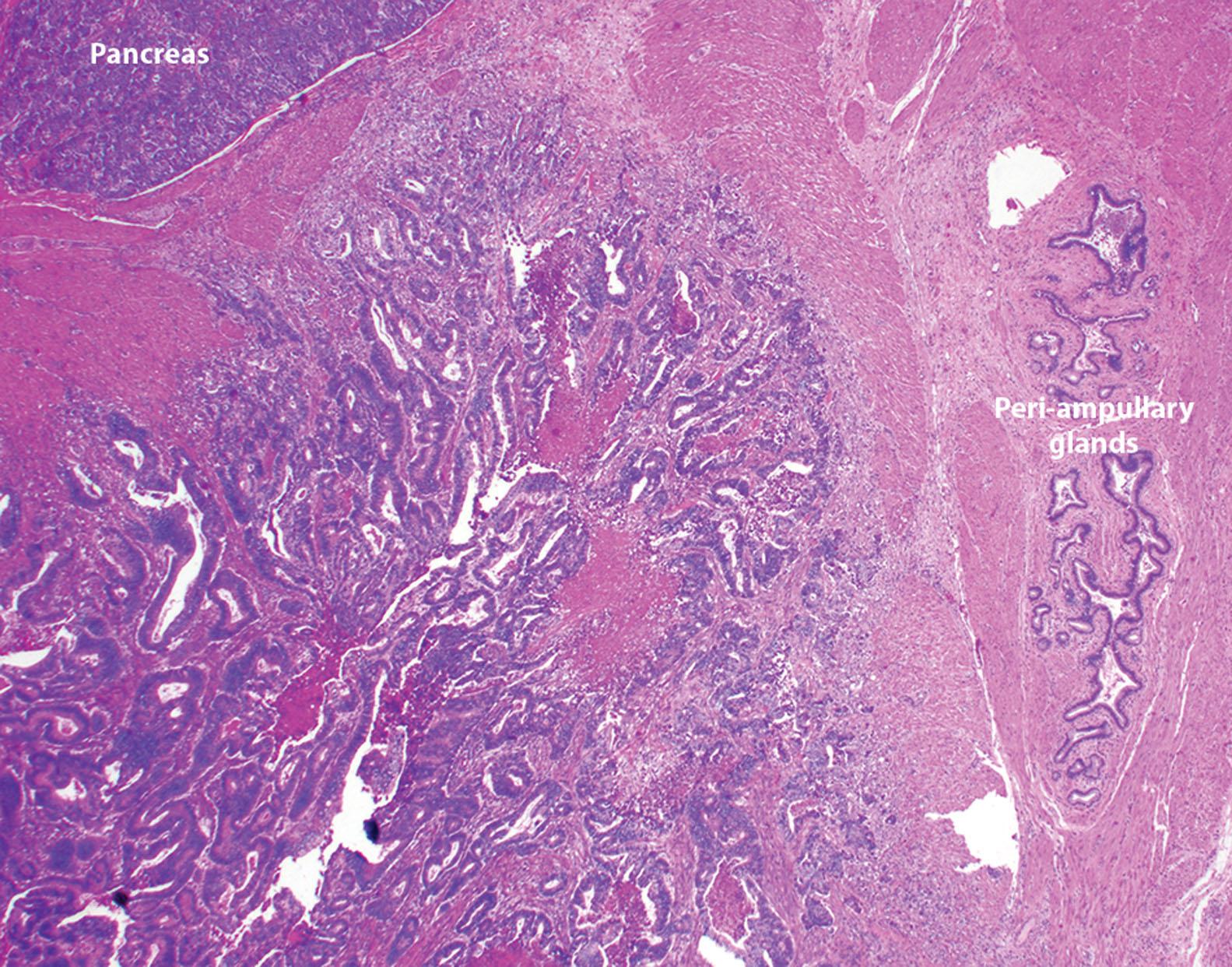
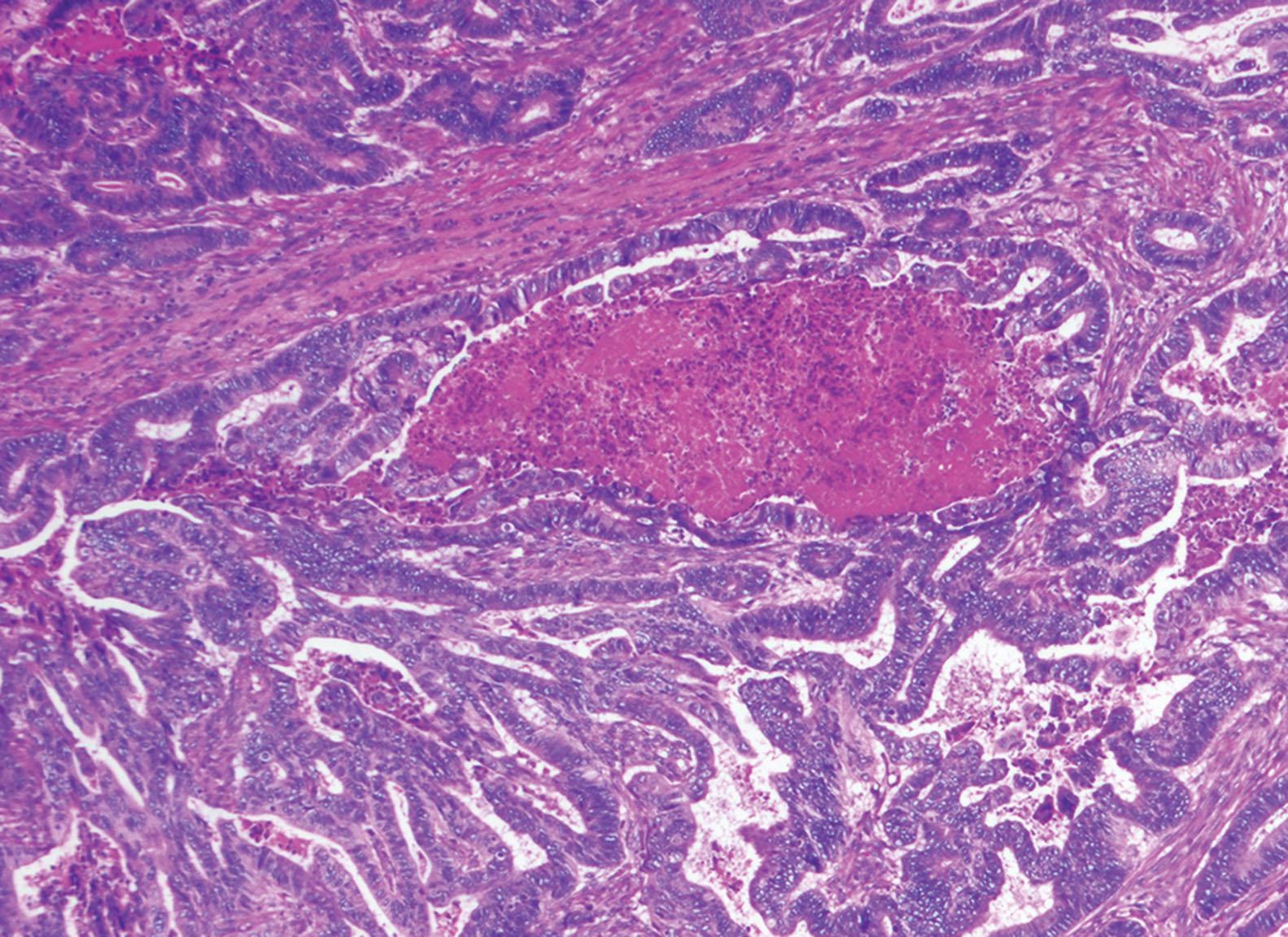
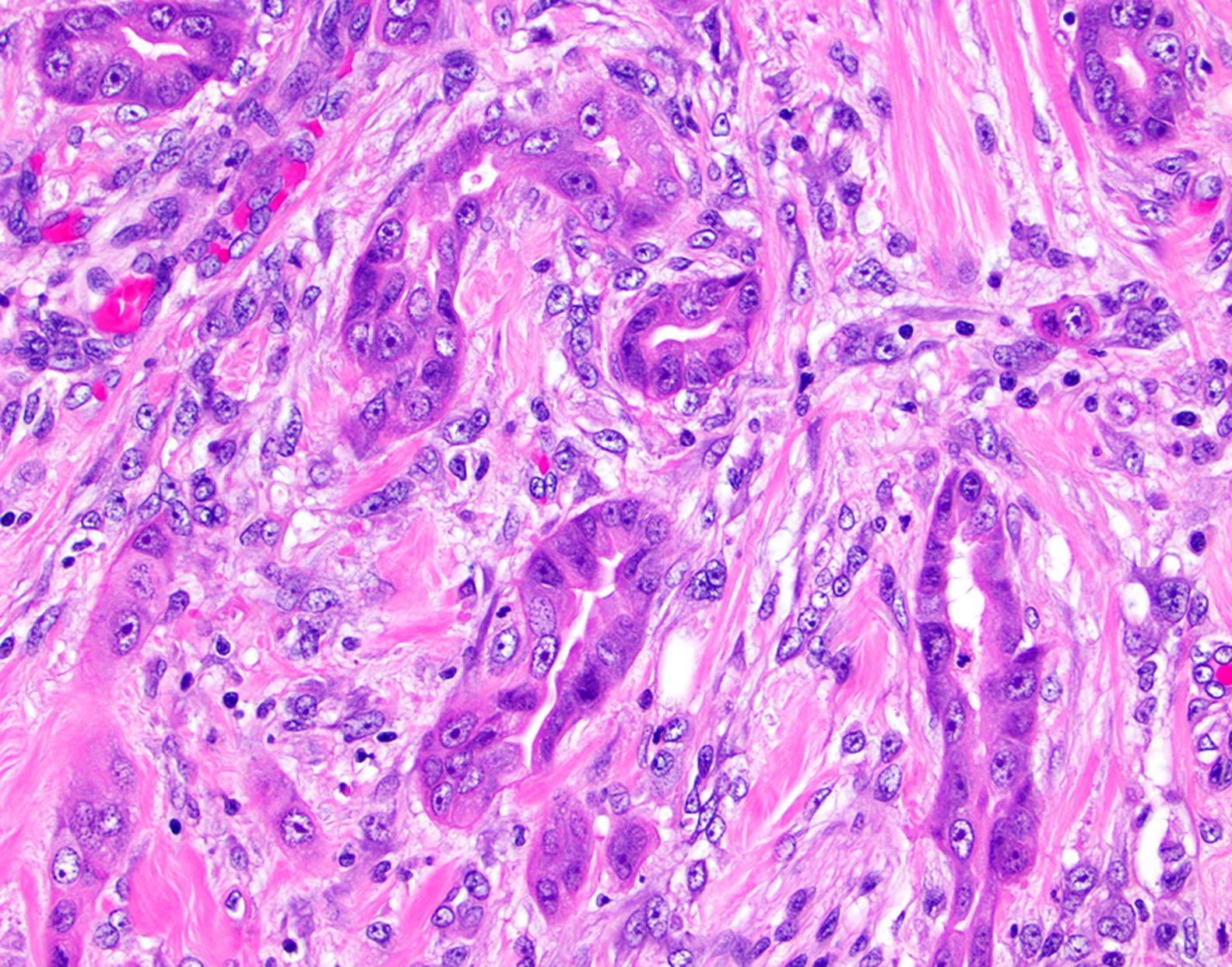
Immunohistochemistry using a panel of CDX2, MUC1, MUC2, and CK20 has been advocated to help subtype adenocarcinomas of the ampulla ( Table 6.2 ). In general, intestinal-type adenocarcinoma is positive for CDX2, CK20, and MUC2 and negative for MUC1. Pancreaticobiliary-type adenocarcinomas are positive for MUC1 and negative for CDX2 and MUC2. However, IHC does not always allow for definitive subtyping, and a mixed or ambiguous immunophenotype is quite common. Other types of ampullary adenocarcinomas (e.g., mucinous, signet ring cell, medullary, adenosquamous, undifferentiated carcinoma) have also been described but are infrequent. Similarly, tumors with a rhabdoid phenotype with SMARCA4 or INI-1 loss are also rarely seen in the small intestine, either as primary or as metastasis from another site.
| Immunohistochemical Subtype | Immunohistochemical Staining Pattern for CK20, CDX2, MUC2, and MUC1 |
|---|---|
| Intestinal | 1. Positive for CK20 or CDX2 or MUC2 and negative for MUC1 |
| 2. Positive for CK20, CDX2, and MUC2, irrespective of MUC1 staining pattern | |
| Pancreaticobiliary | Positive for MUC1 AND negative for CDX2 and MUC2, irrespective of CK20 staining pattern |
| Ambiguous | Other combinations of phenotypes, including negative for all stains |
a Positive staining is defined as more than 25% of tumor staining.
Pancreaticobiliary neoplasms arising in the common bile duct or pancreas can colonize the ampullary epithelium or, if invasive, may directly involve the ampulla and be misdiagnosed as an ampullary adenoma or adenocarcinoma. Careful gross examination and review of clinical and imaging information are necessary when assigning the correct primary site to periampullary tumors. Metastasis from distant sites to the ampulla of Vater is rare but has been reported.
When adenomatous epithelium extends into periampullary glands in the smooth muscle of the sphincter of Oddi, care must be exercised to not misdiagnose the adenoma as an invasive carcinoma. Lack of a desmoplastic response and a clear continuity with low-grade dysplastic ductal epithelium supports a noninvasive diagnosis.
Become a Clinical Tree membership for Full access and enjoy Unlimited articles
If you are a member. Log in here